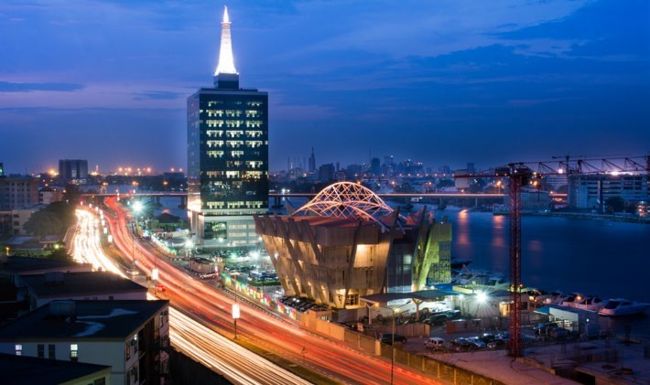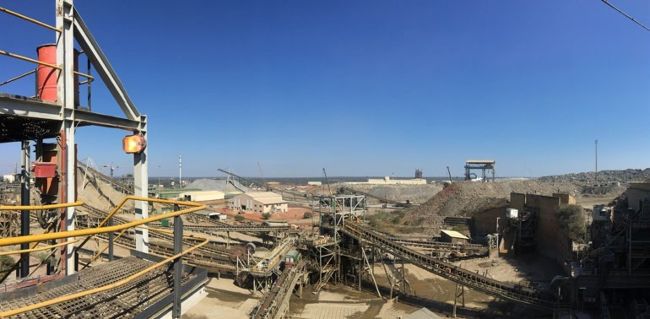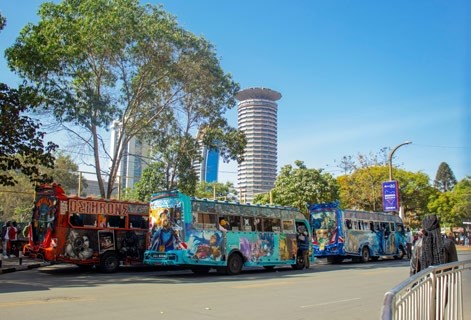ANNIVESARY
Lubezine’s 50th Edition: Atrip down memory lane

Victoria Island, Lagos Nigeria, landscape view of the street at dusk.
SOURCE | SHUTTERSTOCK/BA55EY
L
ubezine Magazine is thrilled to be publishing its 50th edition. When we published the inaugural edition in September 2011, the drive was to cover Africa’s lubricants and lubrication industry with a global outlook in recognition that Africa is the next growth frontier for the lubricants market. Thirteen years later, Lubezine Magazine’s goal has not changed. We are continually working on catering to the needs of maintenance personnel and those of lubricant marketers, additives, and base oils suppliers. We have consistently provided the market with the latest technology information, market news, and technical articles every quarter.
Many African countries have been on an upward trajectory due to a steady pace of growth in sectors such as agriculture, transport, construction, mining, energy, and manufacturing. Coupled with this is an increasing young population ready to propel the continent to the next borders. A growing middle class with more spending power has seen the number of vehicles on African roads increase significantly. All these factors support the assertion that Africa lubricants markets will continue to grow, both in volume and significance; you can count on Lubezine to keep the world informed every step of the way in this exciting journey.
Africa in perspective
In our first edition, we featured articles about the basics of lubrication and the status of Kenya’s lubricants industry. We examined Kenya’s lubricants market landscape from the 1970s to the 2000s, highlighting the multinational oil marketers that entered and those that exited the market and the budding emergence of indigenous oil marketers.
At one time, key multinationals were present in Kenya, such as Shell, Caltex, Total, Agip, Exxon Mobil, and Esso. However, with the market liberalization policies of the 1990s and shifting strategies of multinationals regarding downstream business, many of these multinationals, except Total, exited the scene, and their space was taken up by licensee partners, new Pan-African companies, and Indigenous oil marketing companies.
Nigerian lubricant market today stands as one of the largest in Africa. Here we took an in-depth look at the role industry organizations play in shaping the market. The Lubricants Producers Association of Nigeria (LUPAN), the Standards Organisation of Nigeria (SON), and the Major Oil Marketers Association of Nigeria (MOMAN) all make significant contributions in promoting local production of lubricants, promoting the uptake of high-quality lubricants and safeguarding the interest of consumers through training and combating substandard lubricants

The mining industry in Africa is vibrant and pushing the lubricants demand.
SOURCE|SHUTTERSTOCK/BIZ STUDIO
Next in line was South Africa, a country whose rich mosaic of manufacturing and mining makes its lubricants industry the largest in Africa. While its internal consumption of lubricants by the different sectors is significant, the output by South African lubricant manufacturers is rarely affected by the slowdown in domestic demand, mainly due to exports to the rest of Africa, further cementing the country’s credentials as a supply hub for the nations in the southern part of Africa.
Our journey across Africa has taken us to many other stops: from Egypt, where brand-conscious consumers gravitate more towards multinational lubricants, to Zambia, where the pulsating murmur of copper mines pump up demand for lubricants, to Uganda, where the motorcycle population chokes the roads of Kampala, providing a fertile market for the growth of motorcycle lubricants.
It is said that when you want to feel the pulse of a country’s economy, you should visit the local market. This is particularly true for the automotive lubricants market, which is by far the largest segment in Africa. We have brought you in touch with some of the significant lubricants markets that service the auto industry, from the Aspanda market in Nigeria, Karriokor market in Tanzania, Kirinyaga road market in Kenya to the Mashamba Complex market in Uganda.
>>Thanks to the wellresearched articles submitted by experts, Lubezine Magazine is not only nourishing the thirst for knowledge of those already in the trade but also nurturing the next generation of lubricant professionals.
Some similarities we have witnessed over the years are an increased demand for better-quality lubricants and a growing acceptance of synthetic lubricants. More multinationals have ventured into Africa, and indigenous oil marketing companies have also been on the rise. The challenges that cut across the board are counterfeit lubricants and using the price of lubricants as a determining factor in purchasing a product instead of the quality. The trade barriers among African countries inhibit the full realization of Africa’s potential.
Partnering with Lubes Experts
One stated objective of Lubezine magazine is to contribute to improving lubrication standards in Africa. To achieve this objective, we have tapped into the expertise of various professionals who have graced our editions, either in the 10 questions for lubricant professionals or in feature articles covering lubrication and maintenance.
The ‘10 questions for lubricants professionals’ have provided insights into the different markets and given an overview of their current state and future outlook. Our interviewees have come from far and wide: South Africa, Zambia, Rwanda, Madagascar, Tanzania, Uganda, Kenya, and Nigeria, as well as Europe, Asia, and North America.
The technical articles contributed by these experts have covered a wide range of topics, with maintenance being one of them. The technocrats have covered various topics such as lubricant contamination prevention, preventative and predictive maintenance, and condition monitoring techniques, from oil analysis to vibration analysis, to name but a few.
Thanks to the well-researched articles submitted by these experts, we believe we are not only nourishing the thirst for knowledge of those already in the trade but also nurturing the next generation of lubricant professionals. Our motivation to do this is the gap we see between the needs in the industry and the skills that recent gradu-ates entering the job market have. A good match between labor supply and labor demand is indispensable for graduates and companies and, consequently, for the economy as a whole.
Lubricant Market Shifts
Some of the industry shifts we have been seeing include a preference for Group II base oils over Group I base oils. This trend has also been picking up pace in Africa, and consequently, the quality of the lubricants sold in the market has increased.
Another notable positive shift in recent years is the increased involvement of Oil Marketing Companies (OMCs) in educating distributors, mechanics, and end users on the importance of using high-quality lubricants. This has been to fight counterfeit products. It is commendable to see OMCs getting involved in fighting this vice of counterfeit lubricants that continues to bedevil Africa’s lubes market.
Sustainability has been one of the latest and most vibrant discussions globally. This has required the lubricants industry to be flexible as it has been under pressure to be sustainable in different aspects. There is a shift towards Electric Vehicles (EVs) and their contribution to lowering carbon emissions to help deal with climate change. Unlike Internal Combustion Engine (ICE) vehicles, these vehicles have unique lubrication requirements. The OMCs responded quickly to this, and from additives to finished products, there is an array of products available for EVs.
To further promote sustainability in the industry, most OMCs have been upgrading their lubricant packages to include recycled plastics and have a renewable element in the packaging. Some blending plants have also shifted to using renewable energy like solar to power their operations. Most OMCs have taken up the production of eco-friendly lubricants that do not have detrimental effects on the environment.
The circular economy in the sense of used oil has also been picking up pace. Some companies have the technology to re-refine used oil, remove all the impurities and contaminants, and make new base oils that can be used to create more lubricants. The Circular Economy considers the lubricant’s useful life to the disposal stage; hence, the loop could be closed to eliminate disposal or slowed to increase the useful life, thus not getting to the disposal stage sooner.
We have shone a spotlight on the activities of organizations that are making a meaningful impact in the safe disposal of used oil. These include the Rose Foundation from South Africa, which collects used oil for safe disposal; Kitengela Hot Glass from Kenya, which utilizes used oil as fuel in glass kilns; and Geocyle, a company that is partnering with Vivo Energy Kenya (Shell Licensee); and Bamburi Cement to collect and employ the used oil as fuel in cement kilns.

Kenya’s matatu sector has steadily driven the lubricant demand.
SOURCE|SHUTTERSTOCK/MWIVANDA GLORIA.
Standards are continually evolving, and we cannot forget the IMO 2020 regulation for the marine industry, which mandates a maximum sulfur content of 0.5% in marine fuels globally. This meant the OMCs had to go back to the drawing board to develop lubricants that would be compatible with the new regulations.
>>Growth in agriculture, transport, construction, mining, energy, and manufacturing, coupled with a growing middle class with more spending power supports the assertion that Africa lubricants markets will continue to grow, both in volume and significance.
Then came the COVID-19 pandemic, which shut down the world and businesses alike. The lubricants industry was not spared. With lockdowns and limited movement, the demand for automotive lubricants plummeted. The need for social distancing exacerbated the situation, leading to low production levels in industries and a decline in industrial lubricants demand.
Despite the challenging economic times that came with COVID, it is essential to recognize the noble work done by some OMCs to help humanity during this hard time. Vivo Energy Kenya repurposed its blending plant to produce 350,000 liters of free hand sanitizers. At the same time, Infineum employees donated $345,000, which Infineum matched and gave the money to different charities during the pandemic. We might not mention all the initiatives by the industry, but all efforts are appreciated.
Post-COVID, the lubricants industry started picking momentum again, and it has been on an upward arc trajectory since then. Africa has been beaming with activities ranging from distribution partnerships to acquisitions, multinationals expanding their footprints in the market, and the continued effort to boost knowledge in the industry.
We extend our heartfelt gratitude to all our contributors, advertisers, and dedicated readers, whose unwavering support has inspired us to keep moving forward. Thanks to you, we are proud to present our milestone 50th edition. We are excited to see how the coming years will unfold in the lubricants industry, and we hope you stick around as we bring these updates to you.